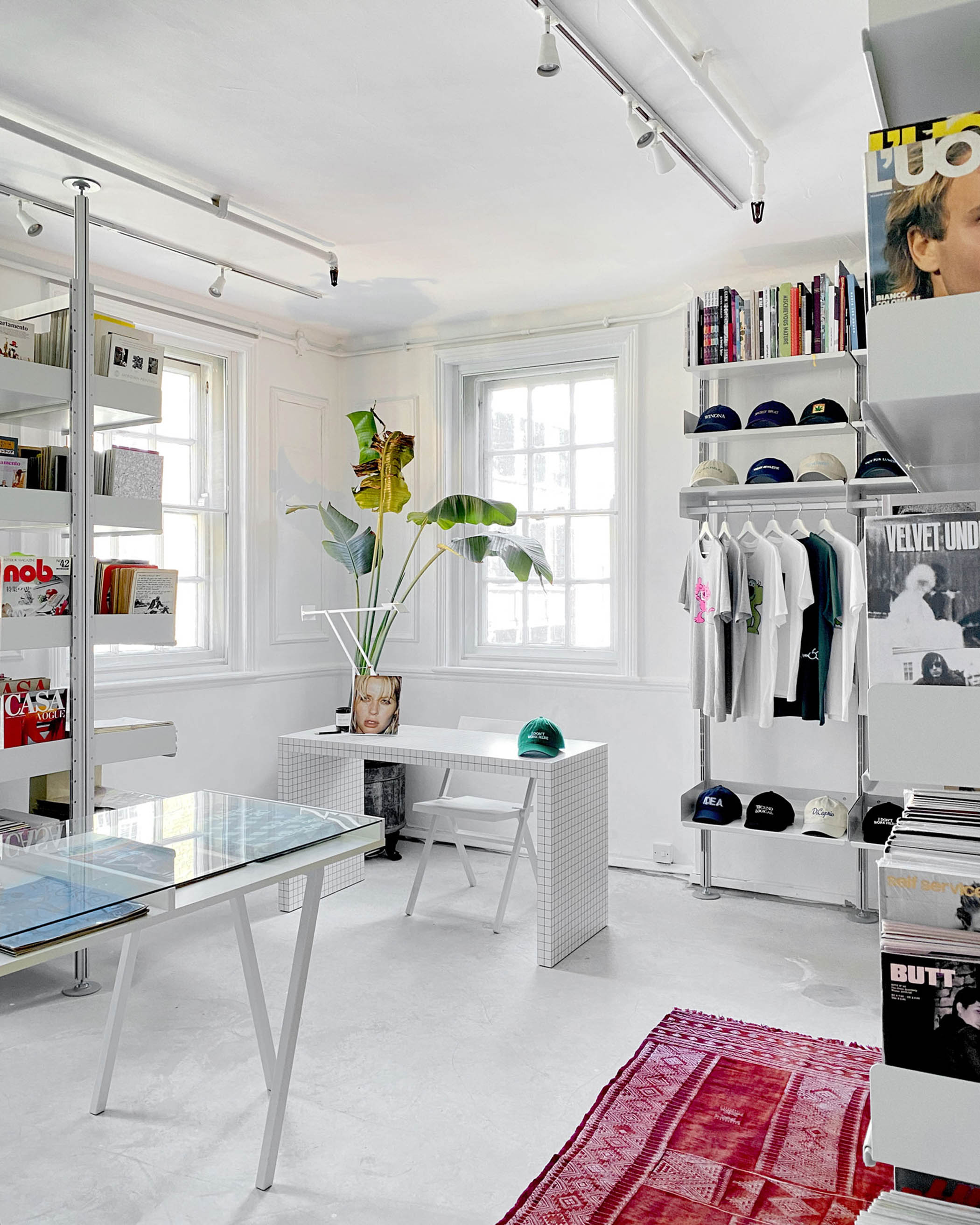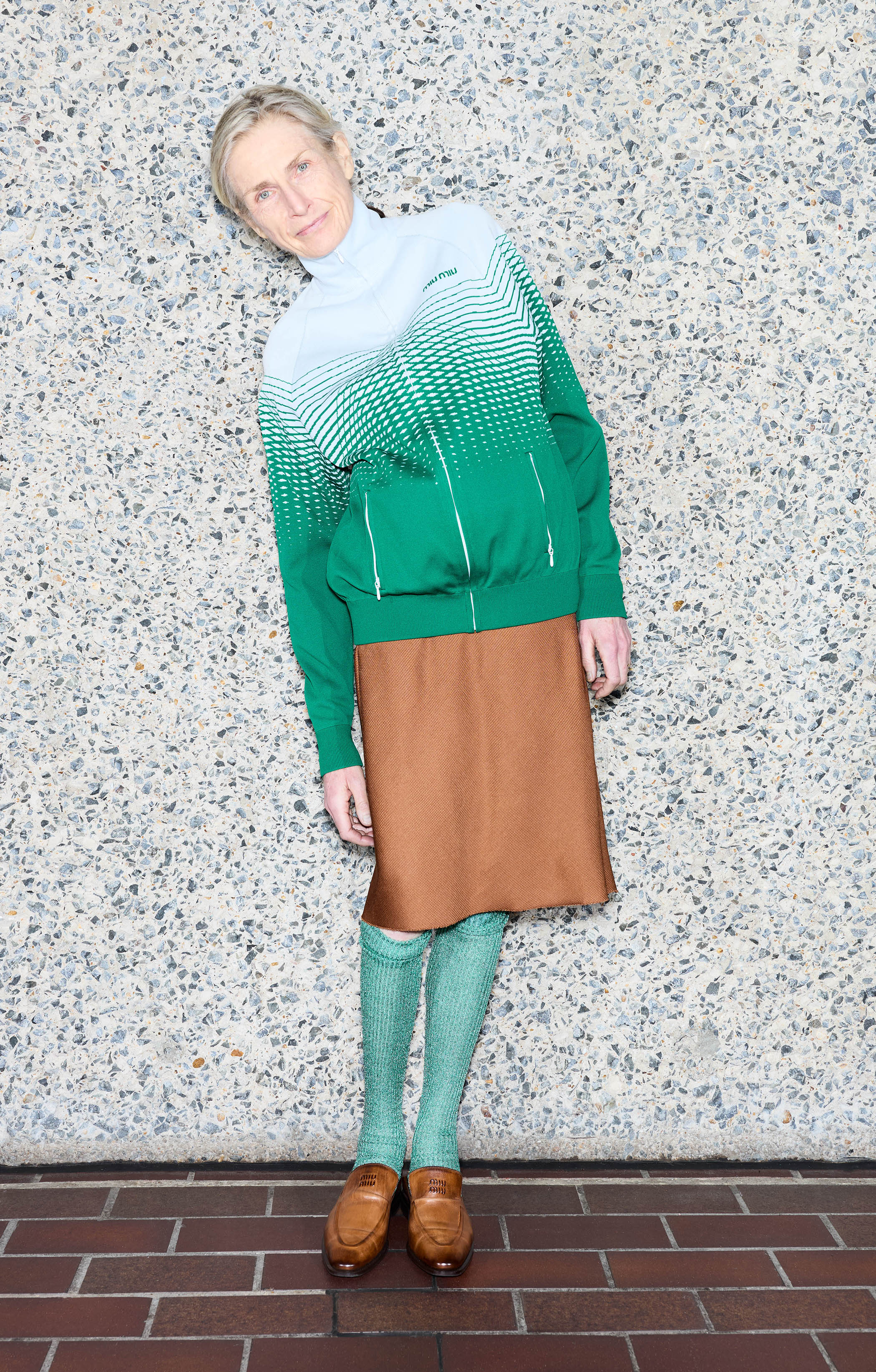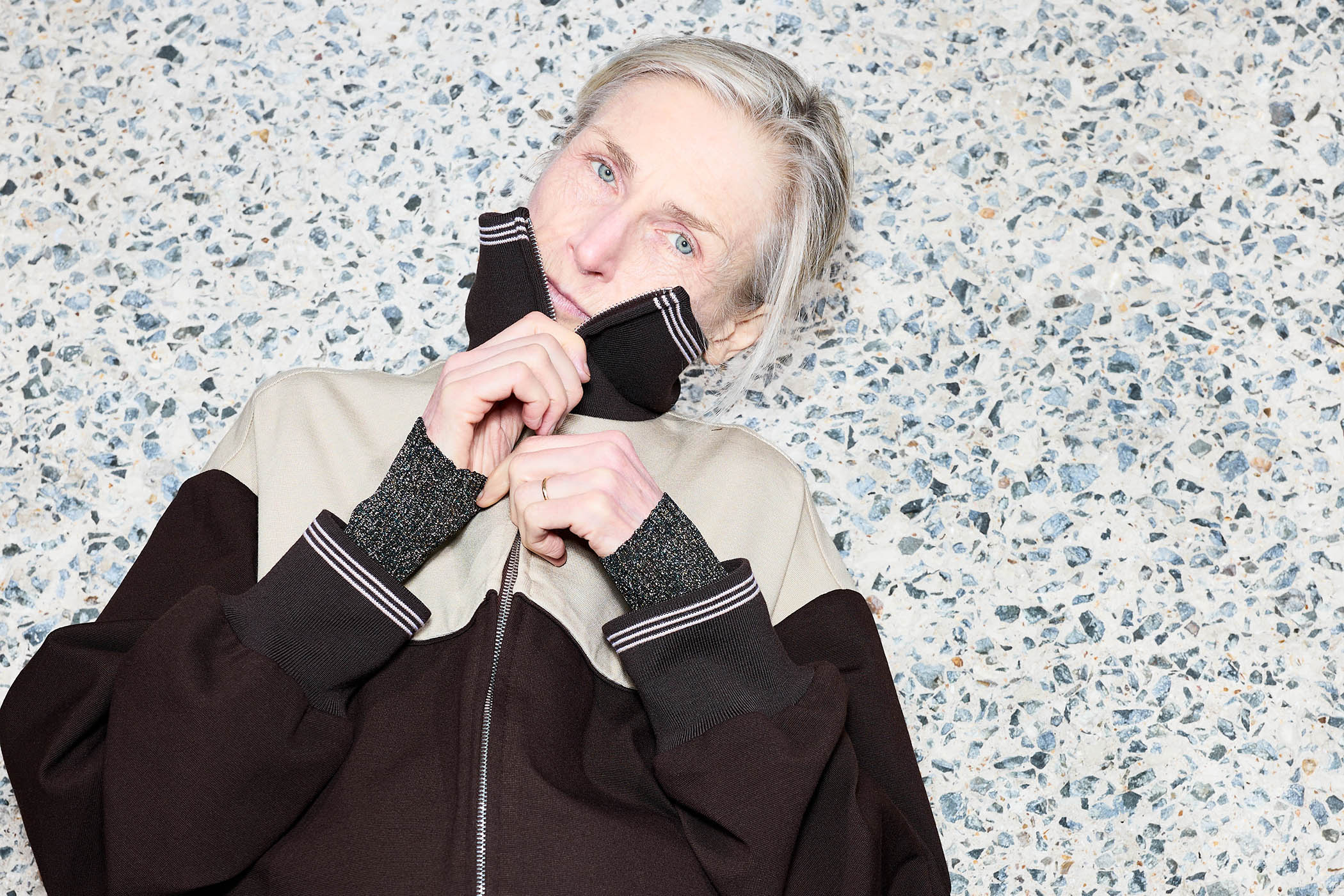Photographs by Jamie Baker
Angela Hill talks about her youth with unambiguous positivity as we sit in a tiny office next door to Idea, the vintage photo bookshop in Soho that she founded with her husband, David Owen, and fills with immaculately preserved fashion magazines, zines and photography books. “It was the best ever,” she says, simply: the only child to beloved parents, the family moved around east London, Stratford to Woodford Green – from where it was always possible to escape the city to go horse-riding in Epping Forest.
Hill is also a renowned fashion photographer. She’s been working since the 1980s, first as an assistant to fashion editors on shoots, then as a photographer in her own right – her first photographs were published in ID. Throughout her career she has remained devoted to and enchanted by one subject: the lives of teenage girls. Her first two photo books, Sylvia (2022) and Edith (2023), released through Idea’s publishing wing, are beautifully rendered depictions of the narrative arc of girlhood. Edith is the younger of Hill’s two daughters. And Sylvia was just a stranger until David approached her mother at the dentist when she was 11 to say his partner would love to photograph her. And so began a six-year relationship between muse and photographer, ending, as Edith does, too, just before Sylvia turns 18.
How did David know Sylvia would be a perfect subject for Hill? “She was just me,” Hill explains. Her voice becomes more girlish and a little dreamier any time she speaks of the past, or past photographic subjects. Sylvia reminded Hill of herself at that age. “The first time I met her, I just knew. I didn’t want to let her out of my life. Like collecting a book, you don’t want to let that one go,” she says. “I’m still like that now: if something comes in and I don’t think I’ll ever see it again, I have to squirrel it home, not put it on sale. Because I have to have it.” There is something agnostic about the collector’s frame of mind, but the contest is not really with other acquisitors, but against the idea of loss itself and the act of forgetting. “Every passion borders on the chaotic,” Walter Benjamin suggested in an essay about his own obsessive book-collecting, “but the collector’s passion borders on the chaos of memories.”

‘If something comes in and I don’t think I’ll ever see it again, I have to squirrel it home, not put it on sale. Because I have to have it’: Idea bookshop
“I’m very often very chaotic,” Hill nods. Like the bookshop itself, every wall of the office is lined with floor-to-ceiling bookshelves stacked to the brim with vintage magazines and sleek full-colour photography books. It is chaotic, but there is also an absolute judiciousness and meticulousness to the way Hill curates Idea: everything on display is thoughtfully, painstakingly presented, right down to which records play on the turntable and which magazines in their laminate protectors are laid out on the white-tiled display table. Though she’s been a collector all her life, Hill , now 61, only realised she could make this passion into a source of income when the now-closed Parisian retailer Colette asked to buy some of her book collection to sell in their shop in the 1990s. After that, Idea was born.
Hill is totally assured in her personal tastes. While working on a photo zine for Idea by the Russian skateboarder and fashion designer Gosha Rubchinskiy, Crimea/Kids, 2014, she knew instinctively that the front and back photographs ought to be swapped around. Rubchinskiy agreed and the zine sold out instantly on publication. “I always think, if this were on show in the shop, am I, Angela Hill, going to pick it up or not?” In listing the up-and-coming fashion designers she’s currently excited about – Julie Kegels, August Barron, Stefan Cooke, Shushu/Tong, Hodakova (all of whom share a playful, irreverent attitude to their fashion design: trousers you wear over your head, skirts as an accessory pinned to your waist) – she was quick to elaborate on those pieces on which she was less keen, mostly because they were too extreme to look real in fashion shoots. Obviously “the real” is an illusion in fashion photography, but it matters to Hill that her photographs look real enough for the viewer to believe in them and so want to inhabit those worlds themselves.
Two floors below Idea, out on Wardour Street, several people held their iPhone cameras at heart-level, approaching strangers to ask them how they look so cool, or so confident, how they look so confidently cool filming the street-fashion vox pops that are ubiquitous on social media. If only they knew how close they were to the ultimate repository of cool, and its architect.
Hill’s relationship to clothing is the outlier to her collector mentality. These days she will buy a whole new wardrobe – seven outfits for the seven days of the week – every season. She selects these pieces as soon as she sees them on the runway, then wears them almost exactly as they were styled in the shows. Currently in her roster there’s a lot of Prada, Undercover, Phoebe Philo and Miu Miu, whose autumn collection she just shot. Her favourite items currently are the pink and brown silky ribbed pieces from Miu Miu, and her suede bomber jacket, also Miu Miu. At the end of the season, she sells everything – having kept it all in perfect condition – and begins again. This militant attitude to her personal wardrobe had its origins in 2019, after a hospital stay caused her to reassess what was actually necessary to her life. She doesn’t miss any of the items she sells. “I get bored easily,” she shrugs. “With fashion and shows, I love the new all the time.” It reminds me of the relationship between the fashion world and its youthful icons: they grow older, lose their sheen, people get bored of them, and then the next tranche is brought in. Like the world of professional sport, fashion has always been a particularly brutal ecosystem.
Hill’s preoccupation with fashion started early. At secondary school she’d read every issue of ID cover to cover, multiple times over, memorising all the looks and their designers. On Wednesdays and Thursdays she’d be out “the bloody door” as soon as the school bell rang – she attended a squarish-sounding London all-girls school, whose teachers were mostly preoccupied with getting kids into Oxbridge – to hit the shops in South Kensington and Knightsbridge (open late on Wednesdays) and Bond Street (open late on Thursdays). The first few times she was too nervous actually to go inside. She was a shy child; she still prefers to be behind the camera, on the outside looking in.

‘As a teenager, everything is vital, frustrating, overwhelming’: an image from Hill’s photo book Sylvia
It was the early 80s and Vivienne Westwood had a new shop on St Christopher’s Place – Nostalgia of Mud – whose store-front was eccentrically draped with fabrics in all shades of brown. “And I would just look,” she says, her eyes a little misty, her voice girlish again, extending the vowels so it came out as “looook”. I imagine her standing in her school uniform, gazing up reverentially at the bold and exotic world just beyond the pane of glass, a religious devotee before an icon, seeing her own reflection overlaid with all these outfits she so desired. When I’d first asked her what drew her to photographing teenage girls, she explained that at that age, “Everything is the most vital, yearning, frustrating, overwhelming. Everything is the most.”
But, it’s all in anticipation.
“In desperate anticipation”, she agrees. “Because you’re so sure of what you want… or you think you are.” You can feel it in Edith and Sylvia: all the desires roiling under the surface of those photographs, in which directions they do not know yet to send them.
What Hill wanted most back then was to enter through the doors and into fashion wonderland. The first designer item she ever purchased was from an early Katharine Hamnett collection. She was studying biochemistry at Dundee university and took a train down to London to visit Hamnett’s shop on South Molton Street where she bought a peach blouse of crinkled Indian cotton. It sent her into overdraft. But oh, it was so beautiful, she recalls, with a blissed expression. She’d wear it with a grey knit Joseph tube skirt, grey cardigan, short DM boots and little white socks.
She loved the whole of that Hamnett collection for its references to Victorian and Edwardian style petticoats, like those in Peter Weir’s film, Picnic at Hanging Rock, in which three beautiful school girls, in long white dresses tied with ribbon sashes, disappear into the crevices of an ominous-looking geological formation in Victoria, Australia, and are never seen again. As such, they remain – for the community from which they came, and the cinematic viewer – forever youthful and unchanged. Picnic at Hanging Rock has formed a significant influence on Hill’s photographic work. In her recent campaign for Miu Miu, young girls drift about through gardens in long woollen pleated skirts, blazers, petticoats and pulled-up socks, beneath old ruins and blue skies which, in certain shots, resemble Hanging Rock.
It’s very human to want to make a permanent record of, and so hold on to, the things that are passing us by, or have already gone. It’s what motivates the photographer, the collector, the diary writer, perhaps most people with a creative practice. One of my favourite photography books published by Idea is Nadia Lee Cohen’s collaboration with Martin Parr, Julie Bullard. Julie Bullard was Cohen’s babysitter as a child in Essex, and the most glamorous woman she had ever seen. In the series of photographs, staged by Hill and taken by Parr, Hill is transformed into a fictionalised version of Bullard. Cohen’s artistic practice offers her a chance to take on another role, to relive her childhood as another person.

‘I get bored easily. With fashion and shows, I love the new all the time’: Angela Hill buys seven outfits to wear daily every season
In her photographs, Hill tells me, she’s always somehow trying to remake the subject into herself. It’s what draws her to figures like Sylvia, who remind her of the child she once was. “Through them I’m recreating my childhood,” she tells me. I ask her why and she tells me, melancholicly – “Because I still want to be there. It was protected and safe, and nothing bad could happen.”
Whereas in adulthood, they can. “And you have to face it,” she responds. “And if you can’t face it, you’ll use tools to help you face it.”
In order to take photographs that feel real – and those in Sylvia and Edith do feel so very real, even as you recognise that they are representations of reality constructed by one person with her somewhat idealised view of youth – Hill must disappear. “I’m not here,” she says to me, curving her hands to form camera lenses and then holding them up over her eyes, which then disappear under shadow. She speaks to an imaginary photographic subject: “Have a look at that leaf or flower, or pick your nose. Have a fag. Do what you were going to do anyway if you were on a walk in the forest. Don’t look at me. I’m not here.” It might seem contradictory, that someone who keeps so emphatically up-to-date with high-fashion trends would also want to shy away from the camera frame. But Hill’s sartorial choices are closer to a protective armour, or a costume behind which she might hide.
Her attitude to her craft reminds me a little of Joan Didion, who once wrote that her only advantage as a reporter was her diminutive stature. It meant people often forgot she was there to capture their likeness and so would act less guardedly around her. Obviously, Didion’s real advantage as a reporter was her extraordinary ability to pin moments to the page in the finest prose. Hill’s real advantage is her unshakeable taste, her ability to know so absolutely the kind of images she desires to make and consume, to spend her whole career fixated on such desires. It’s what makes her bookshop such a success – the bookshop as a repository for one person’s distinctive relationship to longing.
Just as I’m leaving Idea, a young photographer arrives to present her portfolio to Hill, who is encouraging and patient. She asks the girl questions and then asks if she can keep her photos. I wonder what motivates the young photographer, what aspects of her life she is trying to preserve or reconstruct in her images, as Hill does in her photography, and in this bookshop where she engages in a continual battle against the scattering forces of time.
